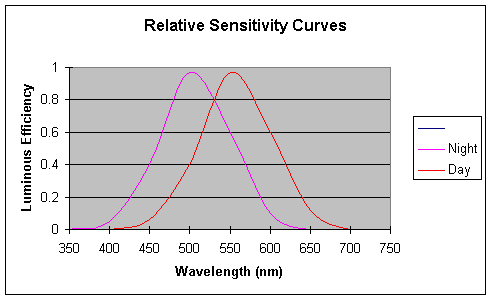|
|
|
When designing an LCD, especially one used with a backlight for use at night, it is always beneficial to "tune" the LCD for use with a specific wavelength of light. This wavelength, needless to say, is dependent upon the type of backlight used, and the drive voltage of that backlight. Let's take a step back and look at how a standard LCD is designed, and we can then modify this design to accommodate our backlight, while keeping in mind the optimum photopic response of the average eyeball. The graph below shows the relative sensitivity curve for the C.I.E. Standard Observer for daylight vision, red (darker) curve, and night vision purple (lighter) curve |
|
|
|
As a practical matter, almost all LCD?s are optimized for about 550 nm, the maximum photopic response of the normal eye during the day. This is easily done by using a simple formula and is a function of the specific fluid used, and the cell gap (the distance between the two pieces of glass). For an explanation of this process, go to our "What is First Minima" App Note.
It is easy to see on the above graph that at night your eyeball will only be about 50% efficient at this wavelength, a real disaster when trying to squeeze every lumen out of your precious battery driven backlight. This is the result of the different relative efficiencies of the different color receptors in the normal eye. Any display optimized for daylight viewing will therefore look dimmer than is necessary. According to the above charts, a display optimized for nighttime viewing should be optimized for about 500 nm and a backlight chosen that emits at this wavelength. One of the nice things about this discussion is that during the day, when the display is read in a normal reflective mode this phenomenon goes away, so that any display optimized for night viewing will also look very good when viewed during the day. The reason is that in a reflective mode the light goes through the display once in each direction, the effects thereby canceling each other out. Also, designing a "First Minima" display doesn't guarantee an optimized configuration, as the equations used to compute "First Minima" have a wavelength component in them, and as you can guess by now, most manufacturers use the 550nm number in the formula. When choosing your LCD supplier, (hopefully Liquid Crystal Technologies) find one who understands and can help with these issues.
When designing a display that will be used in a negative image backlight mode, it is a good idea to discuss these issues in the very beginning of your efforts so that an optimal design is guaranteed. Addressing these issues after the fact usually means time delays and additional NRE charges.
Please call us at (440) 232-8590 if you have any questions about designing an
LCD for your application. |

